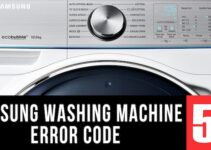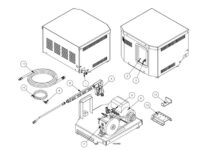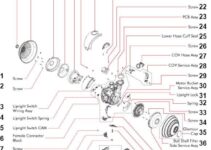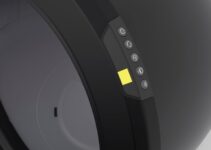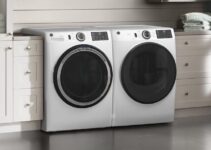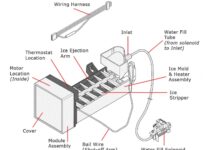Goodman furnaces are known for their reliability and efficiency. But, like all other appliances, they may experience problems from time to time.
This troubleshooting guide provides information on some of the most common problems that can occur with Goodman Furnaces and step-by-step instructions for fixing them.
Goodman Furnace Troubleshooting Manual: Problems & Fixes
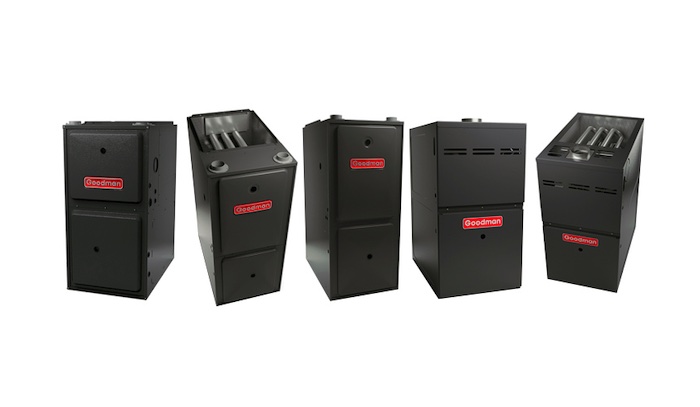
1. Goodman Furnace won’t turn on
This could be caused by a blown fuse or tripped circuit breaker, a thermostat that is not set correctly, or a problem with the furnace’s ignition system.
How to Fix
STEP 1:
Check the fuse or circuit breaker and replace or reset it if necessary. The fuse or circuit breaker is the first thing to check when the furnace won’t turn on. It could be that the fuse has blown or the circuit breaker has tripped, which would prevent power from getting to the furnace.
To check the fuse, locate the fuse box and look for a fuse that is labeled as “furnace” or “HVAC.” If the fuse is blown, it will need to be replaced. If the circuit breaker has tripped, simply reset it by flipping it to the “on” position.
STEP 2
Check the thermostat settings and make sure they are set correctly. The thermostat controls the operation of the furnace, so if it is not set correctly, the furnace may not turn on.
Check the thermostat settings to make sure the temperature is set above the current room temperature and that the system is set to “heat.” Also, check that the thermostat is set to “auto” and not “off” or “on.”
STEP 3
Check the furnace’s ignition system, including the pilot light or electronic ignition, to make sure it is working properly. If the furnace is not turning on and the fuse and thermostat are fine, the problem may be with the ignition system. For furnaces with a pilot light, check that the pilot light is lit.
For furnaces with electronic ignition, check that the furnace is getting power and that the ignition control module is functioning properly. If the pilot light is out or the electronic ignition is not working, you may need to call a professional to fix the issue.
2. Goodmans Furnace is not producing enough heat
This could be caused by a clogged air filter, a malfunctioning thermostat, or a problem with the furnace’s burners.
How to Fix
STEP 1
Check the air filter and replace if it is dirty. The air filter prevents dirt and debris from entering the furnace and clogging the burners. A dirty air filter can restrict airflow, which can reduce the furnace’s ability to produce heat.
To check the air filter, locate the filter compartment, which is usually found on the side of the furnace or near the return air duct. Remove the filter and hold it up to a light. If you can’t see light through the filter, it’s time to replace it.
STEP 2
Check the thermostat settings and make sure they are set correctly. If the thermostat is not set correctly, the furnace may not produce enough heat.
Check the thermostat settings to make sure the temperature is set above the current room temperature and that the system is set to “heat.” Also, check that the thermostat is set to “auto” and not “off” or “on.”
STEP 3
Check the furnace’s burners and make sure they are clean and functioning properly. The burners are what create the heat for your furnace. If the burners are dirty or clogged, they may not be able to produce enough heat.
To check the burners, locate the burner compartment, which is usually found on the side of the furnace. Inspect the burners for any dirt or debris and clean them if necessary.
Also, check that the burners are not clogged with soot or rust. If the burners are dirty or clogged, cleaning them may solve the problem. If the burners are rusty or damaged, they may need to be replaced. It is recommended to call a professional HVAC technician for assistance if you suspect a problem with the burners.
3. Goodmans Furnace is making strange noises
This could be caused by a loose or worn belt, a problem with the blower motor, or a build-up of dirt or debris in the furnace.
How to Fix
STEP 1
Check the belt and tighten or replace if it is loose or worn. The belt turns the blower motor, which circulates the heated air throughout your home. If the belt is loose or worn, it can create a squealing or squeaking noise.
To check the belt, locate the blower compartment and inspect the belt for any signs of wear or damage. If the belt is loose, tighten it by adjusting the belt tensioner. If the belt is worn or damaged, it will need to be replaced.
STEP 2
Check the blower motor and make sure it is functioning properly. The blower motor powers the fan that circulates the heated air throughout your home. If the blower motor is malfunctioning, it can create a humming or buzzing noise.
To check the blower motor, turn off the power to the furnace and inspect the motor for any signs of damage or wear. Check the fan blades for any damage or obstruction.
If the motor or fan blades are damaged, they will need to be replaced. If the motor is not functioning properly, you may need to call a professional HVAC technician to diagnose the issue.
STEP 3
Clean the furnace to remove any dirt or debris that may be causing the noise. If the furnace is making strange noises and the belt and blower motor seem to be fine, the problem may be caused by a build-up of dirt or debris.
To clean the furnace, turn off the power and remove the access panel. Use a vacuum cleaner to remove any dirt or debris that may have accumulated inside the furnace. Be sure to also clean the burners, and check the ducts for any blockages.
4. Goodmans Furnace is leaking
This could be caused by a clogged condensate drain, a problem with the heat exchanger, or a leak in the ductwork.
How to Fix
STEP 1
Check the condensate drain and clear any clogs. The condensate drain carries away any moisture that is produced by the furnace. If the drain is clogged, it can cause water to leak from the furnace.
To check the condensate drain, locate the drain tube, which is usually located near the furnace. Inspect the drain tube for any clogs and remove them as necessary.
STEP 2
Check the heat exchanger and make sure it is not cracked or damaged. The heat exchanger is responsible for transferring heat from the burners to the air that is circulated through your home.
If the heat exchanger is cracked or damaged, it can cause water to leak from the furnace. To check the heat exchanger, turn off the power to the furnace and remove the access panel. Inspect the heat exchanger for any signs of cracks or damage. If the heat exchanger is damaged, it will need to be replaced.
STEP 3
Check the ductwork for any leaks and repair it as necessary. If the furnace is leaking and the condensate drain and heat exchanger are fine, the problem may be caused by a leak in the ductwork.
To check the ductwork, locate the main duct that runs from the furnace to the rest of your home. Inspect the duct for any signs of leaks or damage. If you find a leak, you may need to call a professional HVAC technician to repair the duct.
Wrapping Up
It is important to note that these troubleshooting steps are intended as a general guide and may not be applicable to all furnace models. If you are uncertain about any of the steps or if the problem persists, it is best to contact a professional HVAC technician for assistance. Regular maintenance service to your furnace can also prevent many of these problems.
